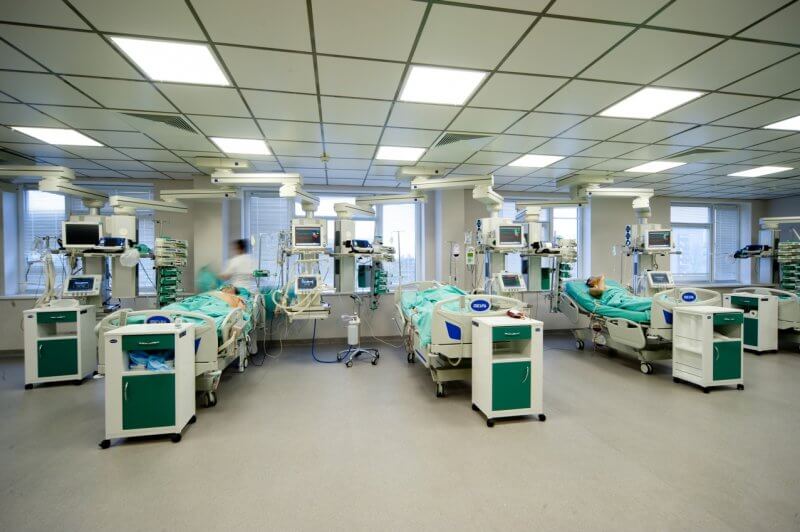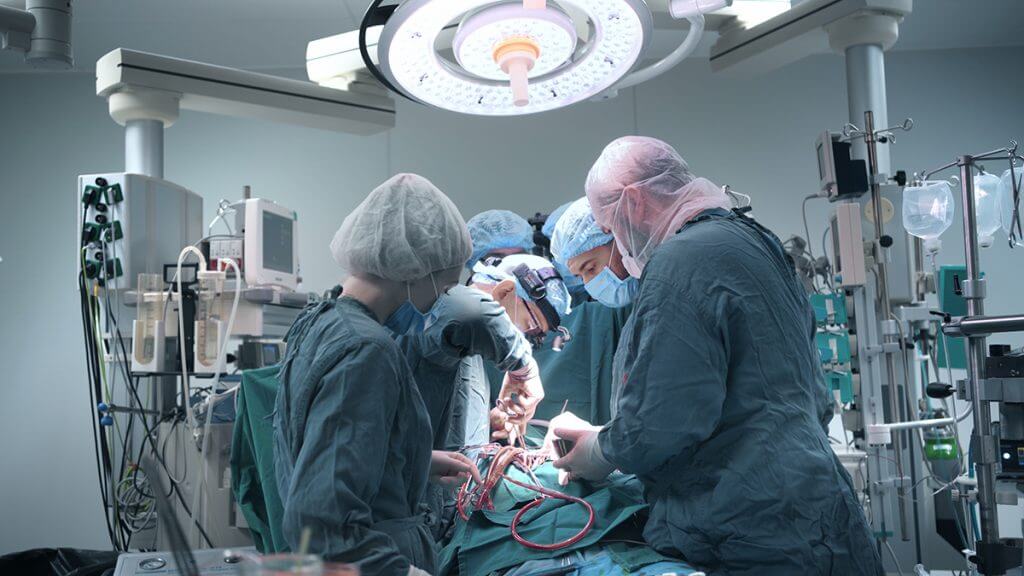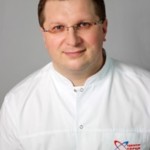What methods of treatment are used at the Heart Institute?
The Institute`s doctors have a wide range of different treatment methods, both standard and innovative.
Ultrafiltration
A method of hardware removal of excess fluid from the body of patients with significant
fluid retention while taking maximum doses of diuretics. Unlike standard hemodialysis,
ultrafiltration allows for continuous control of fluid and electrolytes, promotes the excretion
of cytokines and mediators, and can be used in seriously ill patients.
Mitral valve replacement MVR
The most effective method of surgical treatment of elderly patients suffering from mitral
stenosis and having contraindications to open surgery.
Mitral stenosis is a partial narrowing of the lumen of the mitral valve, due to which blood
cannot normally flow from the left atrium to the left ventricle. Transcatheter mitral valve
implantation refers to minimally invasive intervention. Due to its low traumatism, it can be
used to treat patients with severe concomitant pathology, such as vascular damage, chronic lung, kidney and liver diseases, endocrine disorders, cancer.
Endoprosthetics of the thoracic aorta
A modern minimally invasive technique that allows the implantation of an internal prosthesis on an enlarged area of the aorta. The operation is performed to strengthen the vessel and normalize blood flow. This technique is characterized by low traumatism, does not require a chest incision and is quite easily tolerated by patients.
Endoprosthetics of the abdominal aorta
A less traumatic method that is an alternative to open surgery. The operation does not require extensive incisions. A vascular prosthesis is inserted into the artery on the hip with the help of a catheter, the doctor moves it to the expanded area of the aorta and fixes it on the normal sections located above and below the aneurysm.
Alcoholic ablation of the septal branch of the coronary artery in HCMP
The method of treatment of hypertrophic cardiomyopathy is a disease characterized by a
significant thickening of the heart wall. Transcatheter alcohol septal ablation is a minimally
invasive procedure aimed at reducing the thickness of the septum between the ventricles.
During the operation, the doctor carefully inserts ethyl alcohol through a balloon catheter
into one or more septal branches of the descending coronary artery. This leads to controlled myocardial necrosis in a localized area of the cardiac septum. Treatment allows you to restore the normal functioning of the heart muscle.
Aortic Valve Replacement (AVR)
Transcatheter implantation of the aortic valve is the optimal method of surgical treatment of elderly patients suffering from aortic stenosis and having contraindications to open surgery.
Aortic stenosis is a partial narrowing of the lumen of the aortic valve, due to which blood
cannot normally flow from the left ventricle into the aorta (a vessel that supplies blood to the entire body). Due to the low traumatism of the AVR method, it can also be used to treat patients with severe concomitant pathology. The operation is performed through a puncture in the femoral artery without dissecting the sternum.
Mechanical heart
A mechanical heart (LVAD) is a device that provides mechanical support to the left
ventricle. It can partially or completely replace the function of the cardiac ventricle in
patients with heart failure. As a rule, a mechanical heart is implanted to maintain heart
function during the waiting period for transplantation.
The Heart Institute uses a new generation Medtronic Heart Ware 2 device — the most
popular LVAD (Left Ventricular Assistance Device) in the world. The operation allows
patients to quickly return to their daily activities. They can continue to live as before and
even play sports.
Mini Pacemaker
The size of the mini pacemaker used at the Heart Institute is only 25 mm, and it weighs less than 2 grams. Medtronic Micra is a new generation device. Today it is the smallest
pacemaker in the world.
A minicardiostimulator is installed in patients who have contraindications to open surgery. It is delivered to the heart through a catheter, which is inserted into a vein on the thigh. The surgeon securely attaches the stimulator to the walls of the heart. If necessary, its position can be changed. The device is powered by a powerful battery, charging which lasts for 12 years. Patients with Medtronic Micra can undergo MRI.
Departments of the Heart Institute
Department of Myocardial Pathology and Organ and Tissue Transplantation
One of the most important medical and diagnostic departments of the Institute. Myocardial
pathology is a change in the biochemical structure of the muscular tissue of the heart, which occurs in almost any heart disease — coronary heart disease, myocarditis, acquired defects, cardiomyopathy, hypertension and others. This is not a separate diagnosis. However, do not forget that any cardiovascular disease causes a violation of metabolic processes throughout the body.
A radical method of treatment of end-stage heart failure is heart transplantation. At the
Institute, these unique operations are carried out by specialists of the department headed by Todurov Boris Mikhailovich.
Another area of work of the department is the implantation of a mechanical heart — a device for mechanical support of the left ventricle (LVAD).
Department of Endovascular Surgery and Angiography
Endovascular surgery is a set of minimally invasive procedures aimed at treating
cardiovascular diseases without extensive incisions. The main advantages of this approach are low injury rate, absence of scars, reduced risk of infection and rapid recovery of the patient.
Doctors of the Heart Institute have a special certified education with mandatory internship in leading European and American clinics. Andrey Khokhlov, Head of the Department of
Endovascular Surgery and Angiography, has received an international certificate authorizing independent interventions in operable and inoperable patients with a significant risk of aortic stenosis. At the moment, he is the only Ukrainian doctor with such a certificate.
High qualification allows the doctors of the department to carry out the entire range of
endovascular surgical interventions using the latest generation equipment. The department has four state-of-the-art angiographic systems, which make it possible to perform all angiographic studies and operations without exception in accordance with international standards.
The specialists of the department were the first in Ukraine to implant a balloon expansion prosthesis of the aortic valve in a patient suffering from severe aortic stenosis.
Department of Surgical Treatment of Coronary Heart Disease and Surgery of major Vessels
The specialists of the department are proficient in the following methods of treatment:
• Correction of ascending aneurysm and aortic arch (Bentall procedure, Wheat procedure);
• Valve-sparing operations for ascending aortic aneurysm (David procedure);
• Coronary artery bypass grafting.
The department sees more than 1300 patients a year. More than 800 surgical interventions are performed here every year.
Department of Treatment of Acute Coronary Syndrome and Myocardial Infarction
The department began its work as part of the Heart Institute in 2014. The impetus for its
creation was the increase in the number of patients with urgent cardiac conditions who need hospitalization. At the same time, there was an active introduction of endovascular surgical techniques.
Cardiologists and anesthesiologists-resuscitators of the department work closely with doctors of other specialties of the Heart Institute. Together they provide high-quality cardiological care to patients suffering from:
• Acute coronary syndrome (unstable angina and acute myocardial infarction):
• massive pulmonary embolism;
• Дife-threatening cardiac arrhythmias;
• Exudative pericarditis with cardiac tamponade.
The department also conducts such therapeutic procedures as:
• Endovascular surgery of aortic aneurysm;
• Septal alcohol ablation in patients with hypertrophic cardiomyopathy;
• Implantation of intracardiac occluders;
• Treatment of patients who have undergone coronary stenting and angioplasty.
The department maintains close contact with the coordinating emergency services in Kiev
and receives patients around the clock.
Intensive Care Unit for adults
The department is designed for 24 beds for hospitalization. They provide round-the-clock
medical care to patients with unstable health conditions, who have a high probability of
destabilization or are stably severe.
Patients are served by highly qualified medical staff. Thanks to the use of the latest
stationary and mobile equipment, the doctors of the department monitor the condition and
maintain the vital functions of the body in accordance with international medical protocols.
Department of Cardioneurology
The branch was opened very recently — at the beginning of 2022. It was created to reduce the risk of neurological complications in patients with cardiological and cardiac surgical
diseases. Doctors are also engaged in predicting and monitoring the consequences of
significant ischemic events.
The department is a high-tech innovative rehabilitation therapy center, leading in the country in counseling patients with long-term disorders of consciousness. It is the base for the Department of Neurology of the Bogomolets NMU. Most of the department`s employees are doing postgraduate studies or defending scientific degrees.
Children`s Department
It is one of the most important structural divisions of the Heart Institute. All the necessary
conditions have been created here for high-quality and coordinated work of doctors and
medical staff, as well as a comfortable stay of children and their parents. Since 2007, the
children`s department has been conducting the entire range of diagnostic and therapeutic
procedures in children with congenital heart defects from birth to 18 years.
The specialists of the department are engaged not only in clinical, but also in scientific
activities. They actively adopt the leading experience of their foreign colleagues by attending international symposiums, trainings, congresses and courses.
The main areas of work of the department are:
• Surgical operations for congenital heart defects in pediatric patients of all age groups,
including newborns and premature babies;
• Round-the-clock emergency cardiac surgery for newborn children;
• Consultations of employees of cardiology and neonatology departments of medical.
institutions in Kiev and other regions;
• Screening of newborns with suspected congenital heart defects;
• Dispensary observation of pediatric patients after surgery;
• Cooperation with children`s doctors of city medical institutions and foreign clinics.
The department annually performs more than 450 open-heart surgeries, more than 250
endovascular operations, as well as about 1,500 echocardiograms.
FAQ
What diseases are treated at the Heart Institute?
On the basis of the Heart Institute, medical and surgical treatment of all types of pathology
of the heart and blood vessels in children and adults is carried out, including:
• Genetic, acquired and mixed cardiomyopathies;
• Coronary heart disease;
• PE (pulmonary embolism);
• Monoclapular and combined heart defects;
• Acquired heart defects with concomitant pathology;
• Decompensated pathologies of the heart;
• Acute coronary syndrome and myocardial infarction;
• Disorders of the heart rhythm and conduction of the heart;
• Heart failure.
What modern equipment do doctors use at the Heart Institute?
The Heart Institute uses high-tech equipment that allows doctors to perform complex
operations and diagnostic procedures previously unavailable in Ukraine and abroad.
The cardiopulmonary bypass department is equipped with a device for cascade plasma
filtration of Cobe Spectra and Cobe Optia. Gambro AK-200 UltraS and Fresenius5008 are
used for hemodialysis.
In the treatment of cardiac arrhythmias, doctors use the AXIOM Sensis XP cardiological
computer system (Siemens), as well as the Sarto XP electroanatomic mapping system
(Biosense Webster, USA). With their help, specialists can accurately study the hemodynamic and electrophysiological functions of the heart, visualize a three-dimensional model of the heart to accurately determine the pathological focus in the treatment of arrhythmias.
For radiological diagnostics, a Philips Brilliance CT 64 computed tomograph is used, which
allows obtaining 0.5 mm slices. With the help of the Brilliance Workstation graphic station,
specialists carry out reconstructions of anatomical structures, which allows you to plan
complex surgical interven
tions. Three Practicx 300 mobile X-ray machines are used in the
intensive care unit.
What is the unique feature of the Heart Institute?
The Heart Institute is an exact copy of the Munich clinic Herzzentrum München. At the time of the institut`s establishment, this clinic was one of the best cardiology centers in the world.
Ukrainian architects went to Germany and on their return recreated a German clinic in
miniature in Kiev. The main point that was taken into account during the construction of the
clinic was the correct location of the wards and operating rooms (clean and dirty flows of
staff and patients), as well as other technological nuances.
How successful are mechanical heart implantation operations?
The Heart Institute has already performed 5 operations for implantation of a mechanical
heart. Given the complexity of this surgical intervention, this is quite a lot. Currently, the
institute`s doctors have received the right to perform such operations independently, without the participation of German partners. Since Ukrainian doctors managed to achieve very good results — all patients survived — they were offered to participate in clinical trials together with German colleagues from Berlin. This can be regarded as a confession.
What unique operations are performed for children at the Heart Institute?
The institute`s doctors perform heart surgeries on children weighing up to a kilogram.
Recently, an operation was performed on a child weighing up to a kilogram to a child with a break in the aortic arch. At the moment, there is no information about such surgical
interventions in either American or European sources. Therefore, such operations can be
considered unique. Operated children develop normally. Some of them have already caught up with the development of their peers. He has no neurological deficit, at the moment he is absolutely healthy.
Which heart surgeries are performed only at the Heart Institute and nowhere else in the
world?
At the moment, the institute is performing the Ozaki operation, which was first developed by a professor from Japan. He makes the flaps of the aortic valve from the patient’s pericardium, simply cutting them out according to the pattern.
The doctors of the Institute have improved this operation. They began to model the shutters in a computer using computed tomography data. Thus, the shutters are made individually for each patient, taking into account his anatomical features. They take root perfectly, and a person can not take anticoagulants. This is an innovative procedure that the doctors of the Heart Institute are very proud of.
How to get a consultation or surgery at the Heart Institute?
To consult a doctor or start treatment at the Heart Institute, call one of the phones listed on
the website or fill out the online form. The coordinator doctor will contact you soon. He will
tell you more about the possibilities of treatment at the Heart Institute, help you choose a
doctor, tell you what medical documents need to be collected.
How to get to the Heart Institute?
The Heart Institute of the Ministry of Health of Ukraine is located at 5a, Bratislava str., Kiev.
The journey from Boryspil Airport takes 1 hour and 30 minutes. From terminal D to the
Kharkiv metro station, you can get on route No. 322, then transfer to bus No. 415, which
goes to the stop market «Lesnoy».
The clinic can be reached by car via the E40/M03 highway, the journey time is 40 minutes.
The staff of medical tours will help you with booking a taxi, carsharing or arranging a
transfer. Also, we can pick up a hotel or apartment for you near the clinic without additional
financial expenses.













